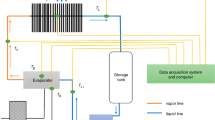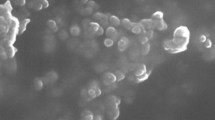Abstract
In order to ensure the normal work of electronic product, the thermal management is of key importance. Miniature loop heat pipe (mLHP) is a promising device of heat transfer for electronic products. Cu-water nanofluid with different concentration is used as working material in mLHP. Experiments are conducted to investigate its heat transfer performance. The heat flux owing to thermal diffusion is calculated. It is found that this heat flux and the boiling temperature are non-monotonic function of concentration of nanoparticle. Turning concentration appears at about 1.5 wt%. Differential equation of thermal diffusion produced by micro movement of nanoparticle is established in this paper. Average speed formula for nanoparticles is derived and slope of the curve of phase equilibrium is obtained. Based on the theoretical research in this paper, enhanced heat transfer mechanism of nanofluid is analyzed. The facts that heat flux owing to thermal diffusion and boiling temperature are all associated with nanoparticle concentration are also well explained with the aid of the derived theory in this paper.




Similar content being viewed by others
Abbreviations
- \(c_{p}\) :
-
Specific capacity
- \(F(\tau )\) :
-
Brownian force
- \(k_{f}\) :
-
Thermal conductivity corresponding to single-phased base liquid
- \(k_{d}\) :
-
Thermal conductivity corresponding to heat diffusion
- \(\Updelta H\) :
-
Enthalpy increase of nanoparticle
- \(\Updelta_{vap} H_{m}\) :
-
Evaporation enthalpy of solvent
- \(m\) :
-
Mass of nanoparticle
- \(\dot{m}\) :
-
Mass of evaporated base liquid per unit volume owing to heat diffusion
- \(n\) :
-
Number of nanoparticle per unit volume
- \(P_{A}\) :
-
Vapor pressure of solvent in weak solution
- \(q_{1}\) :
-
Heat flux corresponding to single-phased base liquid
- \(q_{2}\) :
-
Heat flux corresponding to heat diffusion
- \(r\) :
-
Radius of bubble
- \(R\) :
-
Gas constant
- \(S\) :
-
Area of heating board
- \(T\) :
-
Temperature
- \(T_{w}\) :
-
Temperature of wall
- \(T_{b}\) :
-
Boiling temperature
- \(u\) :
-
Speed of nanoparticle
- \(\bar{u}\) :
-
Average speed of nanoparticle
- \(V\) :
-
Volume
- \(x_{A}\) :
-
Molar concentration of solvent
- \(x_{B}\) :
-
Molar concentration of solute
- \(\tau\) :
-
Time
- \(\rho\) :
-
Density
- \(\mu\) :
-
Viscosity coefficient
- \(\sigma\) :
-
Surface tension coefficient of nanofluid
- ‘:
-
Nanoparticle
- *:
-
Pure solvent
References
Garimella SV, Fleischer AS, Murthy JY et al (2008) Thermal challenges in next-generation electronic systems. IEEE Trans Compon Packag Technol 31:801–813
Dobriansky Y (2011) Concepts of self-acting circulation loops for downward heat transfer (reverse thermosiphons). Energy Convers Manage 52:414–425
Boo JH (2000) Effects of mesh size in a flat evaporator and condenser cooling capacity on the thermal performance of a capillary pumped loop. KSME Int J 14:121–129
Maydanik YF, Vershinin SV (2009) Development and tests of ammonia miniature loop heat pipes with cylindrical evaporators. Appl Therm Eng 29:11–12
Maydanik YF, Vershinin SV, Korukov MA, Ochterbeck JM (2005) Miniature loop heat pipes—a promising means for cooling electronics. IEEE Trans Compon Packag Technol 28:290–296
Li J, Wang DM, Peterson GP (2010) Experimental studies on a high performance compact loop heat pipe with a square flat evaporator. Appl Therm Eng 30:741–752
Singh R, Akbarzadeh A, Mochizuki M (2010) Thermal potential of flat evaporator miniature loop heat pipes for notebook cooling. IEEE Trans Compon Packag Technol 33:32–45
Li Y, Lv LC, Liu ZH (2010) Influence of nanofluids on the operation characteristics of small capillary pumped loop. Energy Convers Manage 51:2312–2320
Arslan G, Özdemir M (2008) Correlation to predict heat transfer of an oscillating loop heat pipe consisting of three interconnected columns. Energy Convers Manage 49:2337–2344
Liu ZC, Gai DX, Li H, Liu W, Yang JG, Liu MM (2011) Investigation of impact of different working fluids on the operational characteristics of miniature LHP with flat evaporator. Appl Therm Eng 31:3387–3392
Choi SUS, Wang X, Xu W (1999) Thermal conductivity of nano-particle-fluid mixture. J Thermophys Heat Transfer 4:474–480
Xuan Y, Li Q (2000) Heat transfer enhancement of nano-fluids. Int J Heat Fluid Flow 1:58–64
Rea Ulzie, McKrell Tom, Lin-wen Hu, Buongiorno Jacopo (2009) Laminar convective heat transfer and viscous pressure loss of alumina–water and zirconia–water nanofluids. Int J Heat Mass Transf 52:2042–2048
Kakac S, Pramuanjaroenkij A (2009) Review of convective heat transfer enhancement with nanofluids. Int J Heat Mass Transfer 52:3187–3196
Wen D, Ding Y (2005) Experimental investigation into the pool boiling heat transfer of aqueous based γ-alumina nanofluids. J Nanopart Res 7:265–274
Johnathan S (2008) Coursey, Jungho Kim. Nanofluid boiling: the effect of surface wettability. Int J Heat Fluid Flow 29:1577–1585
HAN WS, RHI SH (2011) Thermal characteristics of grooved heat pipe with hybrid nanofluids. Thermal Science 15:195–206
Jian Qu, Huiying Wu (2011) Thermal performance comparison of oscillating heat pipes with SiO2/water and Al2O3/water nanofluids. Int J Therm Sci 50:1954–1962
Naphon P, Thongkum D, Assadamongkol P (2009) Heat pipe efficiency enhancement with refrigerant–nanoparticles mixtures, Energy Convers. Manage 50:772–776
Li Y, Lv LC, Liu ZH (2010) Influence of nanofluids on the operation characteristics of small capillary pumped loop. Energy Convers Manage 51:2312–2320
Tang Y, Xiang JH, Wan ZP, Zhou W, Wu L (2010) A novel miniaturized loop heat pipe. Appl Therm Eng 30:1152–1158
Wan Z, Wang X, Tang Y (2012) Condenser design optimization and operation characteristics of a novel miniature loop heat pipe. Energy Convers Manage 64:35–42
Xuan YM, Roetzel W (2000) Conceptions for heat transfer correlation of nanofluid. Int J Heat Mass Transfer 43:3701–3707
Acknowledgments
This work is supported by the Fund of the National Natural Science Foundation of China (Grant No. 21106048).
Author information
Authors and Affiliations
Corresponding author
Rights and permissions
About this article
Cite this article
Wang, Xw., Wan, Zp. & Tang, Y. Heat transfer mechanism of miniature loop heat pipe with water-copper nanofluid: thermodynamics model and experimental study. Heat Mass Transfer 49, 1001–1007 (2013). https://doi.org/10.1007/s00231-013-1144-9
Received:
Accepted:
Published:
Issue Date:
DOI: https://doi.org/10.1007/s00231-013-1144-9




